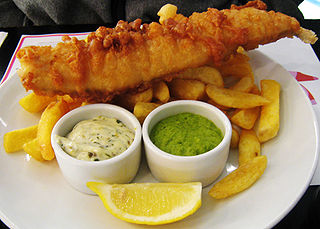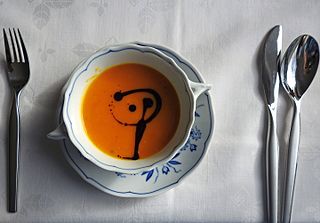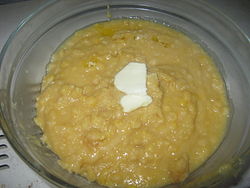
Porridge is a food made by heating or boiling ground, crushed or chopped starchy plants, typically grain, in milk or water. It is often cooked or served with added flavourings such as sugar, honey, fruit, or syrup to make a sweet cereal, or it can be mixed with spices, meat, or vegetables to make a savoury dish. It is usually served hot in a bowl, depending on its consistency. Oat porridge, or oatmeal, is one of the most common types of porridge. Gruel is a thinner version of porridge and congee is a savoury variation of porridge of Asian origin.

Finnish cuisine is notable for generally combining traditional country fare and haute cuisine with contemporary continental-style cooking. Fish and meat play a prominent role in traditional Finnish dishes in some parts of the country, while the dishes elsewhere have traditionally included various vegetables and mushrooms. Evacuees from Karelia contributed to foods in other parts of Finland in the aftermath of the Continuation War.

Vicia faba, commonly known as the broad bean, fava bean, or faba bean, is a species of vetch, a flowering plant in the pea and bean family Fabaceae. It is widely cultivated as a crop for human consumption, and also as a cover crop. Varieties with smaller, harder seeds that are fed to horses or other animals are called field bean, tic bean or tick bean. Horse bean, Vicia faba var. equinaPers., is a variety recognized as an accepted name. This legume is very common in Southern European, Northern European, East Asian, Latin American and North African cuisines.

Russian cuisine is a collection of the different dishes and cooking traditions of the Russian people as well as a list of culinary products popular in Russia, with most names being known since pre-Soviet times, coming from all kinds of social circles.

Mushy peas are dried marrowfat peas which are first soaked overnight in water with baking soda, and then rinsed in fresh water, after which the peas are gathered in a saucepan, covered with water, and brought to a boil, and then simmered until the peas are softened. The mush is seasoned with salt and pepper.

Peasant foods are dishes eaten by peasants, made from accessible and inexpensive ingredients.

"Pease Porridge Hot" or "Pease Pudding Hot" is a children's singing game and nursery rhyme. It has a Roud Folk Song Index number of 19631.

Ful medames, or simply fūl, is a stew of cooked fava beans served with olive oil, cumin, and optionally with chopped parsley, garlic, onion, lemon juice, chili pepper and other vegetables, herbs, and spices. Ful medames is traditionally made in and served out of a large metal jug. It is notably a staple food in Egypt and is considered a national dish, especially in the northern cities of Cairo and Gizah. Fava beans can sometimes be also found in other cuisines in the Middle East, and Africa, though cooked differently.

A purée is cooked food, usually vegetables, fruits or legumes, that has been ground, pressed, blended or sieved to the consistency of a creamy paste or liquid. Purées of specific foods are often known by specific names, e.g., apple sauce or hummus. The term is of French origin, where it meant in Old French purified or refined.

Split peas are an agricultural or culinary preparation consisting of the dried, peeled and split seeds of Pisum sativum, the pea.

Somali cuisine has influenced many different countries mainly due to trade, but traditionally also varies from region to region due to the expansive landmass Somalis inhabit. It is the product of Somalia's tradition of trade and commerce. Some notable Somali specialties include kimis/sabaayad, canjeero/lahoh, xalwo (halwa), sambuusa (samosa), bariis iskukaris, and muqmad/odkac.

Pottage or potage is a term for a thick soup or stew made by boiling vegetables, grains, and, if available, meat or fish. It was a staple food for many centuries. The word pottage comes from the same Old French root as potage, which is a dish of more recent origin.

Nigerian cuisine consists of dishes or food items from the hundreds of Native African ethnic groups that comprise Nigeria. Like other West African cuisines, it uses spices and herbs with palm or groundnut oil to create deeply flavored sauces and soups.

Pumpkin soup is a usually 'bound' (thick) soup made from a purée of pumpkin. It is made by combining the meat of a blended pumpkin with broth or stock. It can be served hot or cold, and is a common Thanksgiving dish in the United States. Various versions of the dish are known in many European countries, the United States and other areas of North America, in Asia and in Australia. Pumpkin soup was a staple for the prisoners of war in North Vietnamese prison camps during the Vietnam War.

Pea soup or split pea soup is soup made typically from dried peas, such as the split pea. It is, with variations, a part of the cuisine of many cultures. It is most often greyish-green or yellow in color depending on the regional variety of peas used; all are cultivars of Pisum sativum.
Bissara, bessara, besarah and tamarakt is a dish in Egyptian cuisine and Moroccan cuisine. The dish contains split fava beans, onions, garlic, fresh aromatic herbs and spices. All ingredients are slowly cooked and then blended together to yield a creamy and fragrant dip or side dish.
















